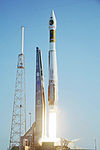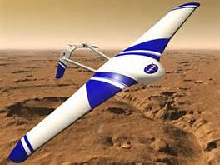Azure in Space: What would a cloud system look like on Mars?
Cloud System on Mars Orbit
[caption id="attachment_23835" align="alignleft" width="100" class="left; width="] Satellite to Mars Liftoff![/caption]
Satellite to Mars Liftoff![/caption]
What would a cloud system look like on Mars? In this case the cloud system would be like AWS, Azure, BlueMix, Google, Rackspace, etc. Just to be clear: Mars doesn't have light fluffy clouds like on Earth. If Mars did have water based clouds, humans would likely have made the technology to get there, but there isn't any surface water. In this intermittent series on Azure in Space, I would like to kick off the series by thinking about the idea of an on-orbit data center for use on Mars.
Now the use of Azure or other cloud technology is beneficial on Earth because of it's flexibility. Being flexible in Mars orbit, where the distances are between 55 million Kilometers and 401 million kilometers, from Earth. Right now, JPL and other space agencies are having to guess at what the requirements will for data processing and data transmission in future exploration scenarios. More data processing on orbit means grams saved on going to the surface of Mars, atmospheric entry from orbital velocities requires heavy equipment, with multiple of grams of mass required for each gram of scientific instrumentation. Each gram, using the ISRO Mangalyaan Mars express costs around $4800 US 2016/gram, but that does not include atmospheric entry systems. So lowering any weight on the landing component is valuable, how valuable, I am not sure, if you know please comment.
Thinking:
But as a scientist you would need to transmit data from your science sensor on the surface of Mars. Direct to Earth is possible. Rovers on Mars are using the MRO and Mars Odyssey to communicate indirectly with Earth. Complex processing requires transmission to Earth and then signals back to Mars, could some of this processing be moved to Mars? What does that look like?
Are there any comparable Earth Satellites or Orbitals
- One candidate might be the Iridium communication systems that is used with IOT on Earth.
- The current Iridium satellite system consists of an array of 66 satellites or orbitals and will be replaced by the next generation satellite: Iridium Next.
- The current Iridium system uses the same chip that the early Mac Power Book used, except the chip used in the Iridium satellite is rad-hardened for space. In fact that might be Mac Power Book used in the movie, "Independence Day" to defeat the aliens, so that is something right?
- Case study of the Iridium satellite system might reveal interesting concepts
- Certainly could experiment with satellite control of an "IOT" system would be interesting
Radios:
In the satellites like the Mars Recon Orbital (MRO) uses software defined radios, which in it's time was difficult to build. In a later blog we will look at one using the nRF24L01, C-code and a remote control toy!
The path of this blog is to demonstrate how to use Mesh Radios with a number of sensors. The reason? But what happens when newly designed, low cost sensors are launched. How do you design a radio system that can handle changing design environments, computer languages, circuits and so forth. Improvements in transceiver and management systems change rapidly and often in ways we don't know will happen. This design philosophy will be applied to the Computational section.
Also, when humans arrive data transmissions will increase, tweets from Mars will be an important of the communications right? Currently, the MRO satellite has transmitted over 200 terabytes of information since it stabilized in Mars orbit. So it is safe to assume that the amount of data will increase. What do we do with all of this data? Much of the data could be relayed to Earth, but some of the information could be processed in Mars Orbit.
So how will the new network of Mars to Earth and back again satellite communication software architecture look like? As I have said, later blog, will discuss the idea of Software Defined Radios.
Background:
[caption id="attachment_23836" align="alignleft" width="220" class="left"] Highly mobile Mars Sensor![/caption]
Highly mobile Mars Sensor![/caption]
There are now, with the successful and efficient launch of India's ISRO's Mangalyaan satellite, 5 operational satellites in orbit around Mars: 3 US, 1 European Space Agency (ESA) satellite, 1 ISRO Mangalyaan satellite. The star of the show in 2016 is the Mars Reconnaissance Orbiter (MRO) and will have fuel to maintain orbit stability through the 2030s. That means that the replacement product should be in the pipeline. I believe that the communications component may be separated from the science mission oriented satellites in the future. If so, then the ISRO Mars Express, which just entered Mars Orbit, looks to fill the communication from science sensors to Earth, or make efficient use of the MRO satellite.
The ISRO Mangalyaan Satellite is a smaller satellite and points to a kind of platform that might augment the MRO mission in the 2020s. The Mangalyaan mass is 15 kilogram, and cost $73,000,000 US to get from the surface of the earth to the orbit on Mars. Using the estimated cost of ISRO launch and the mass of the vehicle to help with sizing during our design phase.
Using the body design of the ISRO Mangalyaan satellite, it's mass equation, then this gives us a platform for imagination. But over a few blog entries, let's take a look at how the Azure cloud architecture could be used on Mars. I will use the Azure based software architecture, however, feel free to reach out with any links you might have a similar discussion using AWS, Bluemix or Google. The cost, energy and mechanical constraints are important for the part of the discussion.
Conclusion:
This is the first of an intermittent series on Azure in Space. Keep an eye out for more as time goes on. In the next two blogs, we will investigate what the software architecture might look like and the develop a software defined radio system, likely using the Intel Edison board as it has Bluetooth and WiFi on the same board.
Comments
- Anonymous
May 14, 2016
Good start, Thanks for the forward-looking article. So, the basic constraint so far is how much computing power can you put on a 15 kg platform? Does the 15kg include power, communications, and station keeping?